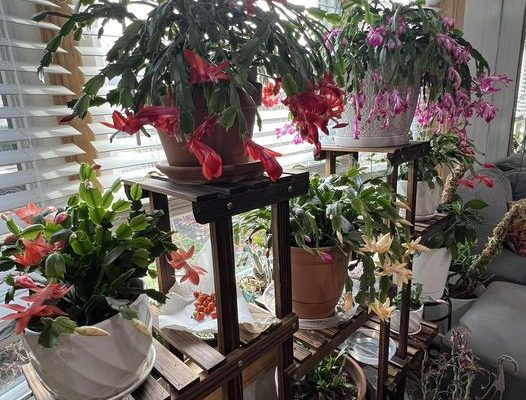If the 12 hours or more darkness is interrupted by turning on lights in the middle of the night, then this can interfere with the development of the cacti flower buds and prevent them from flowering.
Here are the most common reasons and what to do about them.
One thing a lot of newer enthusiasts forget is that plants bloom when they mature.
Christmas cacti will only bloom when they’ve been growing for at least two years.
Disease Or Infestation
It should come as no surprise that a visit from common pests or Christmas cactus diseases can affect more than looks.
Check for any signs of bugs on your holiday cactus, as well as discolored leaves or signs of root rot.
Dealing with these issues, especially early on, can help your plant feel healthier and encourage it to produce flowers.
Fertilizer
Humans tend to harvest most of their food in the autumn, so it’s easy to forget that plants have the opposite feeding cycle.
In nature, winter is a time when organic matter breaks down and enriches the soil.
These nutrients have largely been used up by autumn, causing plants to go dormant until nature can replenish the soil again.
Christmas cacti pay attention to this cycle to help them know when it’s time to bloom.

Apply a general liquid houseplant fertilizer at half strength twice per month in spring and early summer for best results.
Lighting
It might surprise you to know that your Christmas cactus has a sleep cycle.
- During the day, it loves bright, indirect sunlight.
- However, it likes a bit more darkness at night.
- This is especially true around September, when the plant requires 12 hours of darkness daily.
- One way to ensure it gets a good night’s sleep is to move it to a room that can be closed off at night.
If your Christmas cactus is right next to a window that gets direct sunlight during the day, move it back. They can take a bit of sun, but they prefer indirect light.
Another easier method is to cover the plant with a cardboard box at night to block out any potential light.
If using a box, remember to cut some air holes along the bottom so the plant can breathe and enjoy the breezes.
Space
Some plants need plenty of room to stretch their toes (roots), but others, like the Christmas cactus, prefer something a bit cozier.
When transplanted into a larger pot, your cactus will focus on root growth, hoping to achieve that little bit of root binding that makes it feel nice and comfortable.
Think of it like wrapping yourself in a warm blanket on a cold day.
Keeping your Christmas cactus in a pot small enough to allow for slight root binding will make it feel safe, and the plant will begin putting its resources into growing in other areas – such as flowers.
Root rot is caused by overwatering, while stem rot is usually caused by too much humidity or high temperatures. If you think your cactus has root or stem rot,
Species
What sets the Christmas cactus apart from its relatives is the timing of its blooms.
Sometimes a failure in blooming is just a case of mistaken identity.
Have a look at your plant’s leaves (a form of flat, segmented stem called cladophylls), as the shape will often tell you which holiday plant you have.
- Christmas Cactus (Schlumbergera x buckleyi) has flat, scalloped, or teardrop leaves.
- Easter cactus (Schlumbergera gaertneri) has curved scalloping.
- Thanksgiving cactus (Schlumbergera truncata) has spiny edges.
-
Temperature Requirements
Just as you might, Christmas cacti prefer a slightly cooler temperature at night.
The ideal daytime temperature is around 68° to 70° degrees Fahrenheit.
In the evening, these temperatures should be between 60° and 65° degrees Fahrenheit.
The amount of moisture required will depend on temperature, humidity levels, lighting conditions, container size, and the mix your plant is potted in.
In general, Christmas cactus should be watered every 10 days or so in winter and every 7 days in summer (sometimes more often if you live in a sunny, arid climate.)

- In some cases, a bit of breeze can also help your cactus relax when you can’t lower the ambient temperature overnight.
For flowers during the winter holiday season, long nights should be started in late September or October and continued for eight weeks.
If the continued hours of total darkness are interrupted by light, even for a short amount of time, the plant may drop its flower buds.
Remember, your cactus needs to know when it’s winter, so reducing the temperatures around September to October to 55° to 60° degrees Fahrenheit at night can help encourage blooms.
Just be sure not to let drafts reduce the temperature below 50° degrees Fahrenheit, or your plant might suffer damage.
Watering
Your Christmas cactus is adapted to a rainforest environment, so you’ll want to have a decent amount of ambient humidity, such as a pebble tray or humidifier.
Although a Christmas cactus requires frequent watering during the other times of the year, it requires less water right before the blooming season, preventing your plant from blooming.









